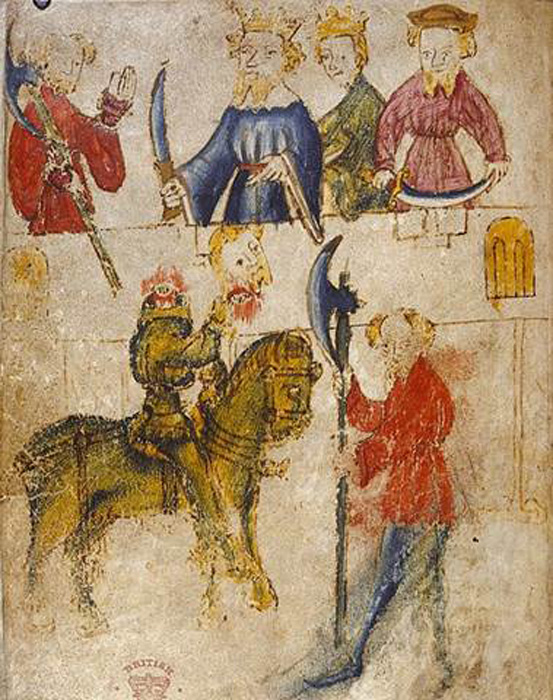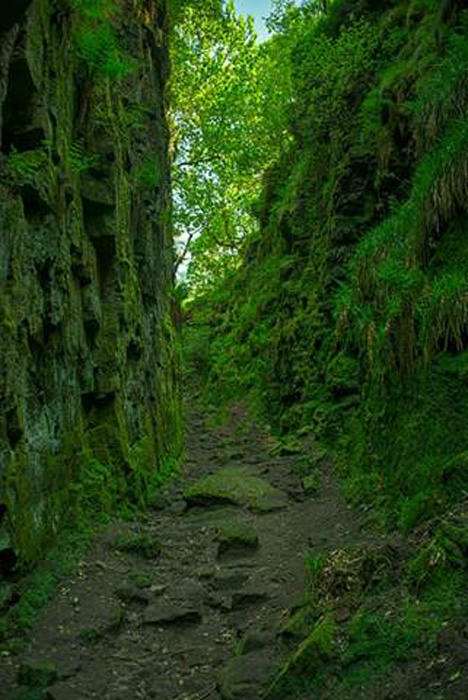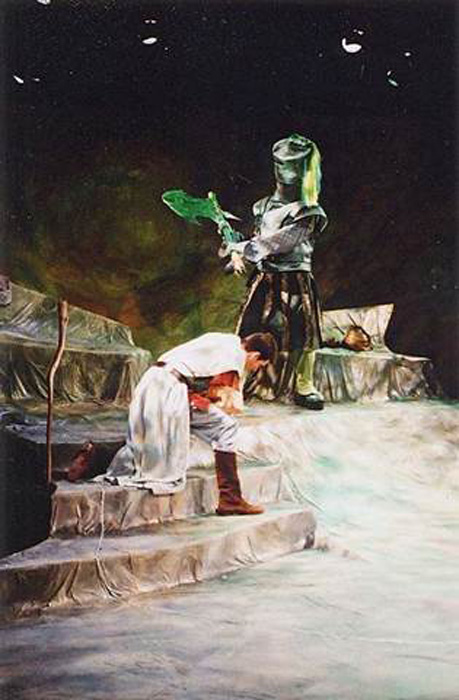There are many stories of Arthur and his knights which survive to this day. The tales stretch across centuries of telling, and have doubtless been rewritten and repurposed many times by many different hands.
However for one of the most strange and symbolic of the stories we apparently have a much better understanding of the man who wrote the poem. The author of Sir Gawain & the Green Knight wrote in such a recognizable dialect that Tolkien thought he knew exactly where in medieval England he lived, and some have even pinpointed where the action took place.
The poem itself, strikingly allegorical and full of dark mystery, may in turn be able to tell us something about the man who wrote it, and the world he lived in.
The Story of Sir Gawain
Sir Gawain and the Green Knight is largely regarded as the finest English-language Arthurian tale. The poem is written in an apparently anachronistic alliterative form, and the strangeness this may have given its recitation permeates the story itself.
The story itself is quite simple. On Christmas Eve, Arthur and his knight are delayed from feasting until they have seen something wonderous. Finally, a knight clad in green enters the great hall and challenges the bravest of Arthur’s knights to single combat.
The Green Knight offers to take any blow, on the condition that in a year he may return the blow to the one who struck it. Sir Gawain steps up and, with a single blow, cuts the knight’s head clean from his shoulders.
However the green knight stands, picks up his head, and leaves the court, binding Gawain to his promise. Gawain’s adventures to meet the Green Knight at his chapel and fulfil his promise, and the people he meets on the way, complete the rest of the narrative.

So much for the story. Already, the strangeness of the tale and the otherworldly figures Gawain meets tell us something about the world in which the poem was written: a world with strange people living beyond the safety of the court, a world in which travel was dangerous, a world full of magic and in which a lesson on honor and morality was apparently needed.
The Author
The poet was clearly a skilled, and well-versed in English romances, as well as perhaps French romances. His world was clearly in regular contact with the rest of England and indeed of Europe, yet the story he told is oddly local and small, no doubt a deliberate choice.
- Was King Arthur Real? Examining the Historical Record
- The Legendary Geats: What Happened to Beowulf’s People?
Its author also appears to have authored the poems Pearl, Patience, and Cleanness, and some researchers believe he may have penned Saint Erkenwald as well. Except for the last all of these works are known from a single surviving manuscript, held by the British Library.
The poet’s religious education was also clearly expansive. In his poems he draws heavily on the Vulgate Bible, and he had a broad understanding of Christian exegesis and sermons, although he never seems to lift directly from religious texts.
Cleanness, Patience, and Pearl demonstrate the poet’s understanding of the Vulgate Bible by their usage of Latin. The poet goes further in Pearl in demonstrating knowledge of not just the Book of Revelation, but also many other chapters of the Bible. The poet probably used a Latin commentary on Revelation and Genesis to write his poem.
His work employs well-known Christian interpretations of Old Testament stories. However it is the literal sense of Biblical materials, rather than their typological or metaphorical value, have appears to have piqued the poet’s curiosity, who then strangely uses them to his own metaphorical ends.
Pearl also demonstrates the poet’s grasp of mystical religion. The narrator “Dreamer’s” description of his vision as a ghostly dream demonstrates the poet’s knowledge of the classification of visions used by mystical theologians and mystics. This does not mean that the poet possessed exceptional knowledge: the majority of religious compositions were widely and easily understood at the time.
By contrast with his Biblical reticence he is prepared to mention contemporary texts by name, such as Jean de Meun’s Roman de la Rose in Cleanness. Some of the terms Pearl uses to describe a mystical experience can only be found in Walter Hilton’s Scale of Perfection which he must have been familiar with. The Gawain author was clearly sophisticated and well read.
The World of the Poet
The poet began writing at a time when English literature was undergoing great change and development. His language was influenced by social developments in the 14th century, particularly the push toward a more anglicized ruling elite and political identity, as well as changes in the English language, mostly driven by exposure to French dialects.
The poet’s literary style is sophisticated, and his references to pastimes like heraldry and hunting indicate that he is writing for a sophisticated audience. But he was not a courtly writer, he descriptions instead betraying a knowledge of the outdoors, the landscape that surrounded him and how to live in it.
The famed author (and expert on Middle English) JRR Tolkien went so far as to identify the poet as coming from the West Midlands of England, most likely Staffordshire. Tolkien was clear in his conclusion: “his home was in the West Midlands of England; so much his language shows, and his metre, and his scenery.”
Based on this, researchers have attempted to pinpoint the locations within the poem as they fit into the author’s landscape. Several candidates for the key locations, most popularly the green chapel from the end of the poem, have been plausibly put forward.

But why write in this deliberately old fashion? Some of the most well-known Middle English poetry can be found in the same collection as his poetry, showing that the poems written by this author were held in high regard. And yet his choice of an alliterative, chant-like form for the poem seems deliberately to create a feeling of something lost in time. Could this deliberate ageing of the poem be intentional?
Was the poet attempting to set something timeless and otherworldly into the landscape that surrounded him? Did he seek to remind readers that there was still magic in the English countryside, or was he trying to suggest that the forests of Staffordshire were ancient, and powerful?
Who was the Poet?
The Gawain Poet’s identity is unknown. One theory is that the poem was written by John Massey, a member of the Cheshire landed gentry who was in the right place at the right time.
Many researchers have suggested that Pearl was written to honor John Hastings, Earl of Pembroke’s daughter, and two of his clerks, John Prat and John Donne, have been suggested as possible authors. Another popular notion in the early twentieth century was that the poems were written by a man named Huchoun (little Hugh), who was attributed with multiple compositions in the Chronicle of Andrew of Wyntoun, including at least one known to be in the alliterative form.
The poet’s identity has also been proposed as Sir John Stanley (c. 1350–1414). The presence of the Garter motto, “Honi soit qui mal y pense”, is put forward in evidence of the author being a Knight of the Garter, as Stanley was. He was also well-versed in hunting and armory, as described by Gawain, and hailed from the proper region of England.
However, ultimately these are just names to attach to a man who we understand far better through his poetry. In fact, it is the poems which offer the most about the man, and knowing his name will give us only a little more detail.

This was a man who loved his countryside, and was very familiar with the activities which took place in it, both courtly and otherwise. This was a man with a grounding in religion and a knowledge of French romance texts, but who preferred to reach for something singularly English in his poetic style.
This was a man who chose to craft an Arthurian tale in an ancient poetic style to suggest tales that, while important, even for him came from long ago. And when we know this much about the man, do we need his name at all?
Top Image: Sir Gawain & the Green Knight is one of the most famous of Arthurian legends. Source: Artie Navarre / Public Domain.
By Bipin Dimri